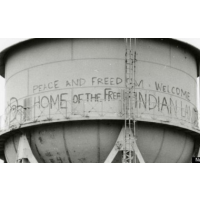In a First, National Park Service Restores and Preserves Graffiti
 (photo: National Park Service)
(photo: National Park Service)
Graffiti can be worth preserving, even if it costs more than a million dollars to do so, according to the National Park Service.
Park Service officials recently spent $1.5 million restoring the water tower on Alcatraz Island in San Francisco Bay, where Native American activists held a two-year protest from 1969 to 1971.
After occupying the famed prison island (which stopped holding prisoners in 1963), the 78 college student protesters painted messages on the 103-foot tower that read: “Peace and Freedom. Welcome. Home of the Free Indian Land.”
Their demands were the conversion of the old prison buildings into a Native American university, cultural center and museum. They also offered to purchase the island for $24 worth of glass beads and red cloth, which, according to their proclamation, followed the “precedent set by the white man’s purchase of a similar island about 300 years ago” (referring to Manhattan, which the Dutch bought from Lenape Indians in 1626).
The activists held vigil on the island without power or running water. Only 12 of them remained at the time federal marshals forcibly removed them 19 months later.
Over time, the hand-painted water tower message began to fade and became hard to read for tourists visiting the island.
So the Park Service decided to shore up the tower and repaint it, which included putting the graffiti—an exact replica, in its original bold red letters—back on the structure to preserve the history of the protest. Native Americans were invited to participate in the restoration. Among them were Fawn and Elijah Oakes, the daughter and grandson of the late Richard Oakes, Mohawk leader of the occupation.
“Normally, the federal government is not in the business of preserving graffiti,” Alexandra Picavet, a Park Service spokeswoman, told The New York Times. “The water tower was the occupation’s most outwardly focused message to the world and it is an important part of the island’s history.”
Alcatraz gets 1.4 million visitors per year, most of whom are interested in seeing the prison that held such notorious inmates as the Al Capone, the “Birdman of Alcatraz” (Robert Stroud) and “Machine Gun [George] Kelly.” However, the graffiti restoration project has resulted in renewed tourist interest in the island’s Native American occupation.
Picavet said that, to the best of her knowledge, this was the only example of modern-day graffiti being restored.
-Danny Biederman, Noel Brinkerhoff
To Learn More:
Antigovernment Graffiti Restored, Courtesy of Government (by Malia Wollan, New York Times)
Alcatraz Occupation Graffiti Preserved (Indian Country Today Media Network)
Alcatraz Water Tower Graffiti Restored, Preserving Memory Of Historic Native American Occupation (by Aaron Sankin, Huffington Post)
- Top Stories
- Unusual News
- Where is the Money Going?
- Controversies
- U.S. and the World
- Appointments and Resignations
- Latest News
- Trump Announces He Will Switch Support from Russia to Ukraine
- Americans are Unhappy with the Direction of the Country…What’s New?
- Can Biden Murder Trump and Get Away With it?
- Electoral Advice for the Democratic and Republican Parties
- U.S. Ambassador to Greece: Who is George Tsunis?






Comments